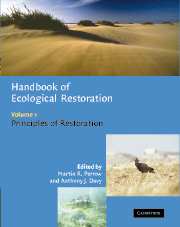Book contents
- Frontmatter
- Contents
- List of contributors
- Foreword
- Preface
- Part 1 The background
- 1 Introduction and philosophy
- 2 Rationale for restoration
- 3 The ecological context: a landscape perspective
- 4 The ecological context: a species population perspective
- 5 The evolutionary context: a species perspective
- Part 2 Manipulation of the physical environment
- Part 3 Manipulation of the chemical environment
- Part 4 Manipulation of the biota
- Part 5 Monitoring and appraisal
- Index
- References
2 - Rationale for restoration
Published online by Cambridge University Press: 29 December 2009
- Frontmatter
- Contents
- List of contributors
- Foreword
- Preface
- Part 1 The background
- 1 Introduction and philosophy
- 2 Rationale for restoration
- 3 The ecological context: a landscape perspective
- 4 The ecological context: a species population perspective
- 5 The evolutionary context: a species perspective
- Part 2 Manipulation of the physical environment
- Part 3 Manipulation of the chemical environment
- Part 4 Manipulation of the biota
- Part 5 Monitoring and appraisal
- Index
- References
Summary
INTRODUCTION
While the world's economic systems have enjoyed unprecedented expansion, ecological systems have been degraded and diminished at an appalling rate. For example, Dahl (1990) notes that approximately 117 million acres of wetlands have been lost in the United States since the 1780s. Excluding Alaska, this wetland loss is approximately 53% (Dahl, 1990). The National Research Council (1992) estimates 4.3 million acres of degraded lakes in the United States and 3.2 million miles of rivers and streams that would benefit from restoration. The degradation of aquatic ecosystems is usually not uniformly distributed throughout most political units, as the loss of wetlands in the United States illustrates (Fig. 2.1). This complicates the funding of and responsibility for aquatic ecosystem restoration. Public awareness that human society's practices are unsustainable was raised significantly at a global scale by the report of the World Commission on Environment and Development (1987). However, awareness must be accompanied by changed behaviour, and there is scant evidence that substantive changes have occurred.
Adults who spent their childhoods in dysfunctional families report that they were unaware of behaviours other than the ones they experienced. Many of these individuals have been fortunate enough to find a model of behaviour other than the dysfunctional one and have incorporated the changed behaviours into their adult lives. First, however, they had to become aware of a different model before they learned of a viable, superior and alternative paradigm.
- Type
- Chapter
- Information
- Handbook of Ecological Restoration , pp. 10 - 23Publisher: Cambridge University PressPrint publication year: 2002
References
- 9
- Cited by

